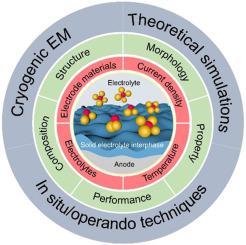Nano Energy ( IF 16.8 ) Pub Date : 2021-09-08 , DOI: 10.1016/j.nanoen.2021.106489 Junxiong Wu 1 , Muhammad Ihsan-Ul-Haq 1 , Yuming Chen 2 , Jang-Kyo Kim 1

|
Solid electrolyte interphase (SEI) is an electrically insulating and ionically conductive passivation layer which is formed on the electrode surface through electrolyte decomposition. SEI is crucial to battery performance because it plays a vital role to determine the Coulombic efficiency, cycle life, capacity, and safety. Given the intricated formation mechanisms and the complicated structures and compositions of SEI, the in-depth understanding of SEI is still challenging. This review is dedicated to critical discussion on recent advances in understanding the formation mechanisms of SEI. The important factors, including electrolyte components, temperature, areal current, and electrode materials, that affect the formation, morphology, structure, composition, and properties of SEI layers are discussed. In situ/operando characterization techniques used to look into the surface morphology, electrochemical performance, chemical composition, structure, and mechanical properties of SEI layers are emphasized. The recent progress of the state-of-the-art cryogenic electron microscopy aimed at atomistic visualization of SEI is highlighted. Multi-scale theoretical simulations employed to study the thermodynamic and kinetic properties of SEI are also discussed. In addition, the SEIs formed on various anodes using solid-state electrolytes are also presented. Finally, the outstanding challenges and future directions in understanding SEI are presented. This review is envisioned to offer new insights into rationally designing the SEI layers for the development of next-generation high-performance rechargeable batteries.
中文翻译:

了解固体电解质界面:高级表征技术和理论模拟
固体电解质界面(SEI)是一种电绝缘和离子导电的钝化层,通过电解质分解在电极表面形成。SEI 对电池性能至关重要,因为它在确定库仑效率、循环寿命、容量和安全性方面起着至关重要的作用。鉴于SEI复杂的形成机制和复杂的结构和组成,对SEI的深入理解仍然具有挑战性。本综述致力于对理解 SEI 形成机制的最新进展进行批判性讨论。讨论了影响 SEI 层的形成、形态、结构、组成和性能的重要因素,包括电解质成分、温度、面电流和电极材料。强调了用于研究 SEI 层的表面形态、电化学性能、化学成分、结构和机械性能的原位/操作表征技术。强调了针对 SEI 原子可视化的最先进低温电子显微镜的最新进展。还讨论了用于研究 SEI 的热力学和动力学特性的多尺度理论模拟。此外,还介绍了使用固态电解质在各种阳极上形成的 SEI。最后,提出了理解 SEI 的突出挑战和未来方向。本综述旨在为合理设计 SEI 层以开发下一代高性能可充电电池提供新的见解。强调了SEI层的电化学性能、化学成分、结构和机械性能。强调了针对 SEI 原子可视化的最先进低温电子显微镜的最新进展。还讨论了用于研究 SEI 的热力学和动力学特性的多尺度理论模拟。此外,还介绍了使用固态电解质在各种阳极上形成的 SEI。最后,提出了理解 SEI 的突出挑战和未来方向。本综述旨在为合理设计 SEI 层以开发下一代高性能可充电电池提供新的见解。强调了SEI层的电化学性能、化学成分、结构和机械性能。强调了针对 SEI 原子可视化的最先进低温电子显微镜的最新进展。还讨论了用于研究 SEI 的热力学和动力学特性的多尺度理论模拟。此外,还介绍了使用固态电解质在各种阳极上形成的 SEI。最后,提出了理解 SEI 的突出挑战和未来方向。本综述旨在为合理设计 SEI 层以开发下一代高性能可充电电池提供新的见解。强调了针对 SEI 原子可视化的最先进低温电子显微镜的最新进展。还讨论了用于研究 SEI 的热力学和动力学特性的多尺度理论模拟。此外,还介绍了使用固态电解质在各种阳极上形成的 SEI。最后,提出了理解 SEI 的突出挑战和未来方向。本综述旨在为合理设计 SEI 层以开发下一代高性能可充电电池提供新的见解。强调了针对 SEI 原子可视化的最先进低温电子显微镜的最新进展。还讨论了用于研究 SEI 的热力学和动力学特性的多尺度理论模拟。此外,还介绍了使用固态电解质在各种阳极上形成的 SEI。最后,提出了理解 SEI 的突出挑战和未来方向。本综述旨在为合理设计 SEI 层以开发下一代高性能可充电电池提供新的见解。此外,还介绍了使用固态电解质在各种阳极上形成的 SEI。最后,提出了理解 SEI 的突出挑战和未来方向。本综述旨在为合理设计 SEI 层以开发下一代高性能可充电电池提供新的见解。此外,还介绍了使用固态电解质在各种阳极上形成的 SEI。最后,提出了理解 SEI 的突出挑战和未来方向。本综述旨在为合理设计 SEI 层以开发下一代高性能可充电电池提供新的见解。











































 京公网安备 11010802027423号
京公网安备 11010802027423号